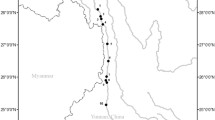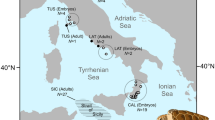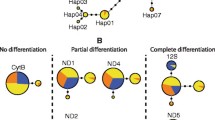Abstract
As a living fossil, the endangered Chinese sturgeon (Acipenser sinensis) has been considered a national treasure in China. Here, the famous Gezhouba Dam and Three Gorges Dam on the Yangtze River were built in 1988 and 2006, for economic purposes. The natural population of Chinese sturgeon has declined since then, as these dams block its migratory route to the original spawning grounds in the middle reaches of the Yangtze River. In 2013 and 2014, there was an absence of spawning where it typically happened near the Gezhouba Dam. Nevertheless, from April to June in 2015, over 1,000 larvae with different body lengths (10–35 cm) were detected along the Shanghai Yangtze Estuary; but only little is currently known about the population genetic structure of the Chinese sturgeon. Herein, we inferred population genetic parameters from 462 available Chinese sturgeon specimens based on a 421-bp fragment of the mitochondrial DNA (mtDNA) D-loop region and 1,481,620 SNPs (single-nucleotide polymorphisms) generated by restriction site-associated DNA sequencing (RAD-seq). For the D-loop dataset, 15 haplotypes were determined. Randomly picked 23 individuals, representing the 15 D-loop haplotype groups, were subsequently used for further RAD-seq validation. The average nucleotide diversity calculated from the mtDNA and RAD datasets was 0.0086 and 0.000478, respectively. The overall effective female population size was calculated to be 1,255 to 2,607, and the long-term effective population size was estimated to range from 11,950 to 119,500. We observed that the genetic variability and the effective female population size of the current population in the Yangtze River are severely low, which are similar to the data reported over 10 years ago. The deduced relatively small effective population of female fish, limiting the genetic connectivity among Chinese sturgeon, should be considered a serious threat to this endangered species.
Similar content being viewed by others
References
Allendorf, F.W., Hohenlohe, P.A., and Luikart, G. (2010). Genomics and the future of conservation genetics. Nat Rev Genet 11, 697–709.
Brumfield, R.T., Beerli, P., Nickerson, D.A., and Edwards, S.V. (2003). The utility of single nucleotide polymorphisms in inferences of population history. Trends Ecol Evol 18, 249–256.
Bruneaux, M., Johnston, S.E., Herczeg, G., Merilä, J., Primmer, C.R., and Vasemägi, A. (2013). Molecular evolutionary and population genomic analysis of the nine-spined stickleback using a modified restriction-siteassociated DNA tag approach. Mol Ecol 22, 565–582.
Brown, J.R., Beckenback, A.T., and Smith, M.J. (1993). Intraspecific DNA sequence variation of the mitochondrial control region of white sturgeon (Acipenser transmontanus). Mol Biol Evol 10, 326–341.
Catchen, J.M., Amores, A., Hohenlohe, P., Cresko, W., and Postlethwait, J. H. (2011). Stacks: building and genotyping loci de novo from short-read sequences. G3 1, 171–182.
Catchen, J., Bassham, S., Wilson, T., Currey, M., O’Brien, C., Yeates, Q., and Cresko, W.A. (2013). The population structure and recent colonization history of Oregon threespine stickleback determined using restriction-site associated DNA-sequencing. Mol Ecol 22, 2864–2883.
Corander, J., Majander, K.K., Cheng, L., and Merilä, J. (2013). High degree of cryptic population differentiation in the Baltic Sea herring Clupea harengus. Mol Ecol 22, 2931–2940.
Dai, Z., Liu, J.T., Wei, W., and Chen, J. (2014). Detection of the Three Gorges Dam influence on the Changjiang (Yangtze River) submerged delta. Sci Rep 4, 6600.
Etter, P.D., Bassham, S., Hohenlohe, P.A., Johnson, E.A., and Cresko, W.A. (2011). SNP discovery and genotyping for evolutionary genetics using RAD sequencing. Methods Mol Biol 772, 157–178.
Excoffier, L., Laval, G., and Schneider, S. (2005). Arlequin ver. 3.0: an integrated software package for population genetics data analysis. Evol Bioinform Online 1, 47–50.
Frankham, R. (2005). Genetics and extinction. Biol Conserv 126, 131–140.
Fu, Y,X. (1997). Statistical tests of neutrality of mutations against population growth, hitchhiking and background selection. Genetics 147, 915–925.
Hohenlohe, P.A., Amish, S.J., Catchen, J.M., Allendorf, F.W., and Luikart, G. (2011). Next-generation RAD sequencing identifies thousands of SNPs for assessing hybridization between rainbow and westslope cutthroat trout. Mol Ecol Resour 11, 117–122.
Hohenlohe, P.A., Bassham, S., Etter, P.D., Stiffler, N., Johnson, E.A., and Cresko, W.A. (2010). Population genomics of parallel adaptation in threespine stickleback using sequenced RAD tags. PLoS Genet 6, e1000862.
Hu, Y., Qi, D., Wang, H., and Wei, F. (2010). Genetic evidence of recent population contraction in the southernmost population of giant pandas. Genetica 138, 1297–1306.
Li, R., Yu, C., Li, Y., Lam, T.W., Yiu, S.M., Kristiansen, K., and Wang, J. (2009). SOAP2: an improved ultrafast tool for short read alignment. Bioinformatics 25, 1966–1967.
Li, F.H.F., and Roderick, T.H. (1970). Computer calculation of wright’s inbreeding coefficient by Cruden’s method. J Hered 61, 37–38.
Librado, P., and Rozas, J. (2009). DnaSP v5: a software for comprehensive analysis of DNA polymorphism data. Bioinformatics 25, 1451–1452.
Macher, J.N., Rozenberg, A., Pauls, S.U., Tollrian, R., Wagner, R., and Leese, F. (2015). Assessing the phylogeographic history of the montane caddisfly Thremma gallicum using mitochondrial and restriction-siteassociated DNA (RAD) markers. Ecol Evol 5, 648–662.
Miller, M.R., Dunham, J.P., Amores, A., Cresko, W.A., and Johnson, E.A. (2007). Rapid and cost-effective polymorphism identification and genotyping using restriction site associated DNA (RAD) markers. Genome Res 17, 240–248.
Park, Y.S., Chang, J., Lek, S., Cao, W., and Brosse, S. (2003). Conservation strategies for endemic fish species threatened by the three gorges dam. Conserv Biol 17, 1748–1758.
Price, M.N., Dehal, P.S., and Arkin, A.P. (2009). FastTree: computing large minimum evolution trees with profiles instead of a distance matrix. Mol Biol Evol 26, 1641–1650.
Pujolar, J.M., Jacobsen, M.W., Frydenberg, J., Als, T.D., Larsen, P.F., Maes, G.E., Zane, L., Jian, J.B., Cheng, L., Hansen, M.M. (2013). A resource of genome-wide single-nucleotide polymorphisms generated by RAD tag sequencing in the critically endangered European eel. Mol Ecol Resour 13, 706–714.
Puritz, J.B., Gold, J.R., and Portnoy, D.S. (2016). Fine-scale partitioning of genomic variation among recruits in an exploited fishery: causes and consequences. Sci Rep 6, 1–6.
Roesti, M., Salzburger, W., and Berner, D. (2012). Uninformative polymorphisms bias genome scans for signatures of selection. BMC Evol Biol 12, 94.
Stamatakis, A. (2006). RAxML-VI-HPC: maximum likelihood-based ph-ylogenetic analyses with thousands of taxa and mixed models. Bioinformatics 22, 2688–2690.
Stamatakis, A., Hoover, P., Rougemont, J., and Renner, S. (2008). A rapid bootstrap algorithm for the RAxML web servers. Systatic Biol 57, 758–771.
Tajima, F. (1993). Measurement of DNA polymorphism. In: Mechanisms of Molecular Evolution, N., Takahata, A.G., Clark, eds. (Sunderland: Sinauer Associates. Inc.), pp. 37–59.
Tajima, F. (1983). Evolutionary relationship of DNA sequences in finite populations. Genetics 105, 437–460.
Tamura, K., and Nei, M. (1993). Estimation of the number of nucleotide substitutions in the control region of mitochondrial DNA in humans and chimpanzees. Mol Biol Evol 10, 512–526.
Tamura, K., Stecher, G., Peterson, D., Filipski, A., and Kumar, S. (2013). MEGA6: molecular evolutionary genetics analysis version 6.0. Mol Biol Evol 30, 2725–2729.
Waples, R.S. (2005). Genetic estimates of contemporary effective population size: to what time periods do the estimates apply? Mol Ecol 14, 3335–3352.
Watterson, G.A. (1975). On the number of segregating sites in genetical models without recombination. Theor Popul Biol 7, 256–276.
Zhang, B.D., Xue, D.X., Wang, J., Li, Y.L., Liu, B.J., and Liu, J.X. (2016). Development and preliminary evaluation of a genomewide single nucleotide polymorphisms resource generated by RAD-seq for the small yellow croaker (Larimichthys polyactis). Mol Ecol Resour 16, 755–768.
Zhang, S.M., Deng, H., Yang, Y., and Wu, Q.J. (2000). Population genetic structure and genetic diversity of the Chinese sturgeon (Acipenser sinensis) based on random amplified polymorphic DNA analysis. Oceanol Limnol Sin 31, 1–7.
Zhang, S.M., Wang, D.Q., and Zhang, Y.P. (2003). Mitochondrial DNA variation, effective female population size and population history of the endangered Chinese sturgeon, Acipenser sinensis. Conserv Genet 4, 673–683.
Zhang, S.M., Wu, Q.J., and Zhang, Y.P. (2001). On the taxonomic status of the Yangtze sturgeon, Asian and American green sturgeons inferred from mitochondrial control region sequences. Acta Zool Sin 47, 632–639.
Zhang, S., Zhang, Y., Zheng, X., Chen, Y., Deng, H., Wang, D., Wei, Q., Zhang, Y., Nie, L., Wu, Q. (2000). Molecular phylogenetic systematics of twelve species of Acipenseriformes based on mtDNAND4L-ND4 gene sequence analysis. Sci China Ser C-Life Sci 43, 129–137.
Zhao F, Zhuang P, Zhang T, Xu JM, Liu JY, Zhang LZ, Wang M, and Shi Q. (2015). New timing record of juvenile Acipenser sinensis appearing in the Yangtze Estuary (in Chinese). Mar Fish 37, 288–292.
Zhu, B., Zhou, F., Cao, H., Shao, Z., Zhao, N., May, B., and Chang, J. (2002). Analysis of genetic variation in the Chinese sturgeon, Acipenser sinensis: estimating the contribution of artificially produced larvae in a wild population. J Appl Ichthyol 18, 301–306.
Zhuang, P., Zhao, F., Zhang, T., Chen, Y., Liu, J., Zhang, L., and Kynard, B. (2016). New evidence may support the persistence and adaptability of the near-extinct Chinese sturgeon. Biol Conserv 193, 66–69.
Zhuang, P., Kynard, B., Zhang, L., Zhang, T., and Cao, W. (2002). Ontogenetic behavior and migration of Chinese sturgeon, Acipenser sinensis. Environ Biol Fishes 65, 83–97.
Acknowledgements
This work was supported by National Natural Science Foundation of China (31370047, U1301252), Shenzhen Scientific R & D Grant (GJHS20160331150703934), Shenzhen Dapeng Special Program for Industrial Development (KY20160102) and Zhenjiang Leading Talent Program for Innovation and Entrepreneurship.
Author information
Authors and Affiliations
Corresponding authors
Electronic supplementary material
Table S1
Sample information for this study
Table S2
Estimates of genetic distance between sequences. COI-H1 and COI-H2 represent the 2 haplotypes of COI. Evolutionary analyses were conducted by MEGA6
Table S3
Variable nucleotide sites within the 421-bp amplified mtDNA D-loop (light strand) of Chinese sturgeon (A. sinensis)
Table S4
Collective information of the specimens (used for RAD analyses), sequence data, unique stacks, loci and SNPs
Rights and permissions
About this article
Cite this article
Liu, J., You, X., Xu, P. et al. Assessing the genetic diversity of the critically endangered Chinese sturgeon Acipenser sinensis using mitochondrial markers and genome-wide single-nucleotide polymorphisms from RAD-seq. Sci. China Life Sci. 61, 1090–1098 (2018). https://doi.org/10.1007/s11427-017-9254-6
Received:
Accepted:
Published:
Issue Date:
DOI: https://doi.org/10.1007/s11427-017-9254-6




